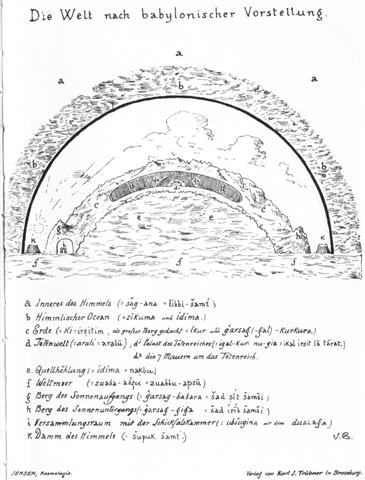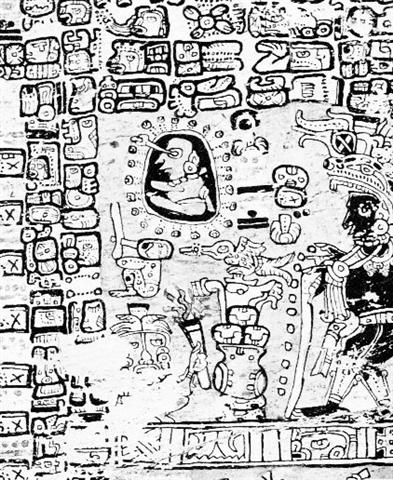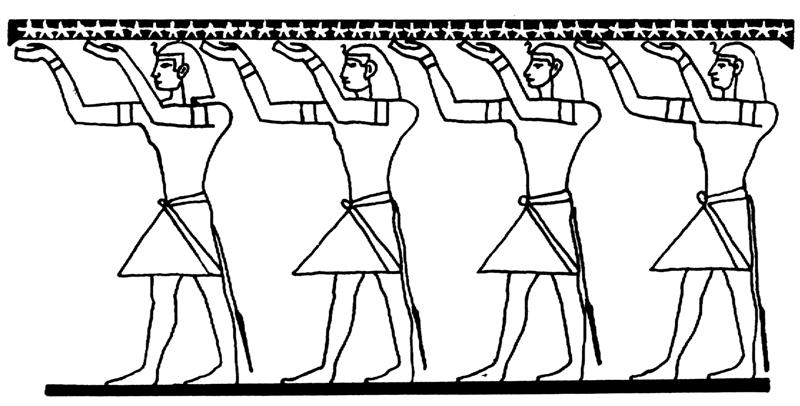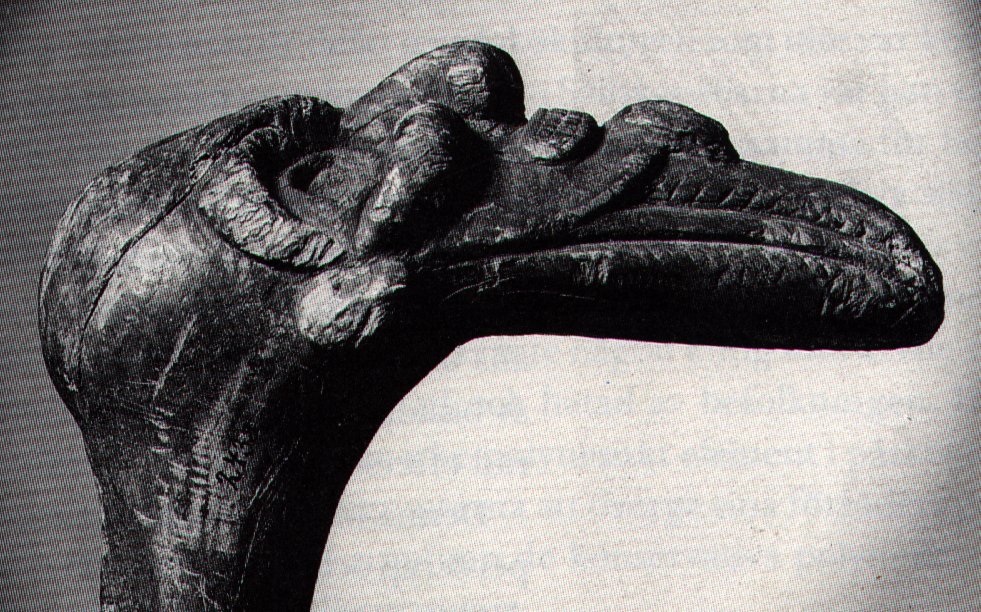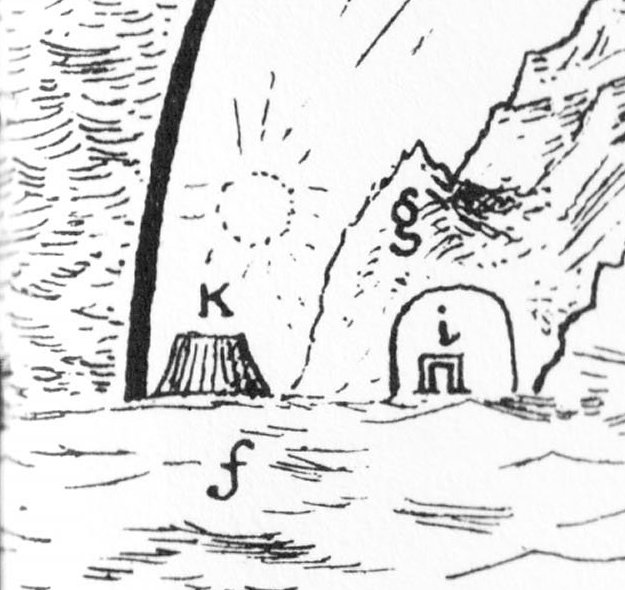|
TRANSLATIONS
Now we arrive at the 2nd period of the day. We recognize the signs of the young sun 'eating light' in order to grow. Then follows a variant of what may be a picture of henua with two holes, the most recent of which has been opened (i.e. the pit in the east from which sun just has reentered into our world). Up in the glyph means recent (present tense), down means some time ago (past tense). Though because time revolves the bottom hole lies both in the past and in the future. In Qa5-45 the sun rays are rising behind the 'mountain of the earth'. The horizon is not horizontal . The old Babylonians imagined that the earth was higher in the middle (like the 'belly' of an overturned boat) and that inside the bulging earth there was a waterfilled hollow:
Though Jensen cautions that this picture is just a product of his own mind, after having assembled information from different sources. He doubts that this total once was in the minds of the old Babylonians. Why not? The Easter Islanders saw Poike as the height and Rano Kau as a waterfilled mountain down at sea level. We start our work by taking a closer look at Qa5-43, comparing it with 1) the similar glyphs in Q 2) the similar glyphs in A, H and P:
1) I cannot find any difference between the glyphs in the 2nd and in the '4th' periods. In the '5th' period, on the other hand, things are changing, as is reasonable when we reach noon. What these noon changes may be is a matter we will return to later in due course.
2) Disregarding the glyphs at noon (5th period) we first of all notice two facts: - H and Q have no 3rd period - H and Q are similar also in having hua at center bottom. Obviously this sign of hua characterizes a.m., the time when sun is not yet fully grown, still 'eating light'. The wording (and glyphing) 'eating light' does not mean that sun literally eats light. We once were considering this as a problem: From where would the sun get new fire?Now, however, we should understand that 'light' may have a deeper meaning: without light you cannot 'see' anything, i.e. you will not understand (and learn) anything. 'Eating light' therefore should be translated as 'growing', not just physically growing but all that growing implies - also mentally. Whether this 'growing', which clearly is indicated in the glyphs, really means not just physically growing but also carries with it the rest of what growing implies we do not know yet. During a.m. (periods nos. 2-5) the sun is growing, a fact we can observe from the emanation of light and heat. All four texts agree on this. That is the central message regarding a.m.-time. Conveying this information to the reader the creative artists have - it seems - agreed on the similarity with a growing little childas a basis for how to write about a.m. To illustrate the idea of growing an open mouth and a hand in position for feeding has been used. As to who (or how) this growing occurs, the artists seem to differ in their views. In H and Q it is (as a rule) the child's own arm and hand which generates this growing, whereas in A somebody else (mother?) delivers what is necessary for growing (because the 'feeding arm' is a separate entity in the glyphs). Possibly we should understand this difference in how to write the a.m.-glyphs as mirroring differences of view about how education best is managed, learning on your own or having somebody to teach you. If this growing process is just a matter of beeing fed food (and drink), then - obviously - the method of writing in A is the 'right' one. If this growing process includes also the mental side, then the method of writing according to H and Q may seem more reasonable. Real learning must proceed from experience and experience cannot easily be transferred to another person. The hua feeding himself should therefore be the 'right' method. Surely also the writers of A and P knew this, but they avoided stressing the hua character of morning sun. The conclusion is that in A and P the writers did not intend to write about sun as a person, they just used the similarity of a child for conveying the information about the observed physical growing of the sun during a.a.-time. In H and Q, on the other hand, the artists were writing also about sun as a person. We are now able to draw a conclusion about the glyphs for the first period in H and Q:
It is sun as hua we see, not yet born (not yet feeding himself). Why don't we see a fish? Because a fish would destroy the message the artists are trying to convey, that the sun is a person. Though possibly we should imagine that the 'flames' are fins? No, I don't believe so. But maybe we here have an explanation for the sun-glyph in the 2nd period of H, where there is an extra curious-looking 'flame' at left:
If the artists of H and Q excluded clear fish-signs in order to show hua, that would not be a complication for the artists of A and P. And indeed, we find in P sun as a fish:
I believe that the variant of sun seen in the 3rd and 4th periods is a 'composite' of sun and fish:
I also believe that the sunfish means that the sun is moving rather quickly across the sky, like a fish in the waters of heaven. I think there are evidence in the rongorongo texts for non-appearance of sunfishes at 'solstice' (where sun seems not to move). In the 2nd period of P the fish-sign is not evident (possibly though the first 'flame' at left is a fin). Instead the idea of growing is introduced. In the 3rd and 4th periods that idea is not needed any more - it is enough to show the sun feeding himself. And in addition it is then possible to transfer the next idea to the reader: that sun is moving quickly (like a fish). In the 3rd period we also receive the message that sun has a boat - the arm has a form reminding us of the 2nd period of A:
Which means that we should not read P as meaning that the sun is a real fish. It is just the suggestion of sun's quick movement that is written by way of the sunfish. His boat is travelling fast. If the sign of fish is used to convey the meaning 'quick movement' then we would have trouble using the same sign of fish also to convey the meaning of 'the evil fish with a very long snout' (Tama). Though, of course, the artist perhaps had no intention whatsoever of doing that. In the 3rd period of A (when already the boat has been introduced) there is room for the artist to convey also the message that the growing sunlight is illuminating the bulging surface of the earth:
The moon-like shape would then be earth in the form of an overturned boat. The sickle of the moon, in comparison, usually is not so sharply bent. Therefore I earlier identified the sickle in this glyph as a variant of haga (the bent wooden bough). That reading is still possible, because boats are built of wood. And miro (wood) also means 'ship', there even is a suggestion of symbolic boats built of earth, miro-oone:
Illustrating the earth in a way similar to the moon conveys the meaning of a close connection between moon and earth, something desirable in the sign. Moon and earth are close, sun and the rest of the celestial bodies are moving on the body of another Nut than Moon. Indeed, the curious idea of the earth as an overturned boat might well have its ultimate explanation from this fact, that moon and earth are close. At this point in our investigation we should continue with the fate of the skull of Hotu A Matua (as it is described in Barthel 2): "Night came, midnight came, and Tuu Maheke said to his brother, the last-born: 'You go and sleep. It is up to me to watch over the father.' (He said) the same to the second, the third, and the last. When all had left, when all the brothers were asleep, Tuu Maheke came and cut off the head of Hotu A Matua. Then he covered everything with soil. He hid (the head), took it, and went up. When he was inland, he put (the head) down at Te Avaava Maea. Another day dawned, and the men saw a dense swarm of flies pour forth and spread out like a whirlwind (ure tiatia moana) until it disappeared into the sky.
Tuu Maheke understood. He went up and took the head, which was already stinking in the hole in which it had been hidden. He took it and washed it with fresh water. When it was clean, he took it and hid it anew. Another day came, and again Tuu Maheke came and saw that it was completely dried out (pakapaka).
He took it, went away, and washed it with fresh water until (the head) was completely clean. Then he took it and painted it yellow (he pua hai pua renga) and wound a strip of barkcloth (nua) around it.
He took it and hid it in the hole of a stone that was exactly the size of the head. He put it there, closed up the stone (from the outside), and left it there. There it stayed." My idea here is that the head of Hotu A Matua (the sun) is a kind of hua, the next generation (solar cycle) will grow from this head. Like a nut the skull will generate a new cycle. We should remember that sick Hawaiian boy Mokuola who couldn't live without his father's (Ulu) skull first being buried in the garden.
The potent dry cranium (pakahera) is the seed to be received by the female (rega), who will then be transformed into a mother (nua), that is what I think. By a remarkable coincidence (though I am now used to this type of 'synchronism', to use the term coined by Jung) this day's newspaper informs about a Mexican cranium which also was painted:
The Mexican indians saw death as an act of solidarity: if nobody dies, then there will be no births. El dia de muertos has its roots in the old indian religion and it resembles Halloween. The reason why this day's newspaper published the information - of course - is that the end of October has arrived. The reason why this synchronism occured to me is that uncounsciously I have come to pace the seasons of the year. There was absolutely no planning in my conscious mind to arrive here in the translation of the day calendar. The staring eyes of the Mexican cranium makes me remember the picture of a Mayan astronomer reaching out with his eyes for the stars:
"Fig. 2, taken from the Madrid Codex, a Maya document written shortly before the conquest, reflects the central role of astronomy among the civilizations of Mesoamerica. It shows an astonomer observing the stars. Seated in his station, he seems to be plucking them out of the sky with his extended eyes. The skywatcher is surrounded by hieroglyphs and Maya numbers which presumably relate to his astronomical secrets." (Skywatchers) I imagine that the power of the skull is located to the eye holes. The eyes are able to reach out into immense distances, they must be very powerful. There are two eye balls, one for each half of the year (I think). Or, in the dayly scheme of things, one for a.m. and one for p.m. Perhaps that explains why there are two 'arms' in the first glyph reaching for the western regions:
These 'arms' of 'headlight beams' streaming out from the cranium of yesterday's sun are ending in Y-signs, and these Y-signs are bony dry 'hands'. There are parallel glyphs suggesting that Y-signs at the end of 'light arms' indeed are 'hands', e.g.:
Probably it is no coincidence that the person at left has an ordinary hand whereas the person at right has an Y-type of hand, because the person at left has a 'light' pendant on his string, whereas the person at right has a 'dark' pendant. Y is a sign of 'night'. Let us now return to the text in Q. We need time to assimilate. Is there any reason to reconsider what the type of glyph represented by Qa5-44 may mean?
If the two 'eyeballs' represent a.m. and p.m., then we understand why one 'sun ball' has escaped out into the open. There is also a suggestion of the beak of a cock. In the morning cocks call out and cocks are considered as symbols of the sun, perhaps because of this behaviour. From the top of church towers they can get sight of the rising sun before anybody else. In the Mamari moon calendar a similar type of beak appears when the moon reappears again after the dark nights (Ca6-28):
Clearly this beak does not represent a copy of the natural beak of a cock (nor the ordinary shape of the cock's head). The strangely curved beak signifies haga, I believe. At the beginning of the day and at the beginning of the month there is a 'curvature' in 'event-space'. Dramatic changes occur. If we extend the image of two 'suns' (eyeballs, a.m./p.m. etc to include other phenomena), we should also consider the possibility that these glyphs (with parallels) contain two 'suns':
The bottom one (hua) we already from the beginning identified as the solar disc, and then we understood that the one at top must be the sun too. Therefore there are two suns in this type of glyph. But up until now we have regarded the top sun as a kind of extension of the bottom one, identified with the body (or later hua or 'skull'). The top sun is the head of the sun and the bottom his 'yolky' part. However, there is another interpretation: At bottom we see the a.m.-sun (flames are not yet on top, still only three flames pointing downwards). At top there is something growing (symbolized by eating). But this growing thing is not the sun (or a sun). Instead what is gradually growing (upwards) are the pillars pushing up the sky and thereby letting in the light. I have noticed that there is a type of glyph which I have decided to call toko te ragi (pillars holding up the sky) and which seem to appear at cardinal points in the texts of rongorongo:
This is a picture of an arm with hand at top. The idea (I believe) is to illustrate an arm holding up the sky, similar to what is illustrated in this Egyptian picture:
That this type of glyph is a kind of arm can be seen e.g. by these parallel glyphs:
I.e. it is not the sun which is growing (of course not, he is always the same), it is the light from the sun which is growing. And to illustrate that the picture of a stylized arm (implying pushing up the sky letting in light) is used. But - here we momentarily will be confounded - is there not at the top of this kind of sun-glyph a head that is eating? Shouldn't we decide whether it is a head or if it is a hand? We are confused because in our own culture things should be defined. On the other side of the earth that is not so important. "... Chinese thought, always concerned with relation, preferred to avoid the problems and pseudo-problems of substance, and thus persistently eluded all metaphysics. Where Western minds asked 'what essentially is it?', Chinese minds asked 'how is it related in its beginnings, functions, and endings with everything else, and how ought we to react to it?" "An important quality of Rapa Nui art is what I call transformation or morphosis attributes. Morphosis is a Greek word which means the action or process of changing or forming. In many Rapa Nui woodcarvings, some stonecarvings and some petroglyphs we see that faces or bodies change from human to bird or other forms depending on such variables as the angle from which the carving is being viewed. This sculptural quality has been called visual punning, but such a term inaccurately implies that the artisan's intent is humorous when, in fact, something far more important is indicated." (Van Tilburg) Example of a woodcarving (picture from Heyerdahl) showing a 'bird-man', bird seen from one direction, man seen from another direction:
Why should we worry about what something is? We should instead worry about the relations between the manifold signs we see and the relations between these signs and their intended meanings. Now to Qa5-45:
Influenced by the new ideas we here see the straight powerful rays of the sun stretching upwards from a point still below the horizon, pushing the sky up and letting the light in. The Babylonians had the same idea (ref. Jensen), that the sky was pushed up by the 'spring' sun: "Marduk, die Frühsonne des Tages und des Jahres, wurde eben wegen dieses seines Charakters der Lichtbringer am Weltmorgen. Marduk, der die leblose, chaotische Nacht, die keine Gestaltungen erkennen lässt, besiegt, der den Winter mit seinem Wasserfluten, den Feind des Naturlebens, überwindet, wurde der Schöpfer des Lebens und der Bewegung, der Ordner des Regellosen, der Gestalter des Unförmlichen am Weltmorgen." "Die Sonne, die des Morgens das Weltmeer durchschreitet und besiegt und das Licht bringt, lässt aus dem Chaos der Nacht zuerst den Himmel, dann erst die Erde hervortreten, spaltet das gestaltlose Reich der Nacht in die zwei Hälften, den Himmel und die Erde." Taking care of this information we may draw the conclusion that it is the sky which is being illuminated, not yet the earth, in Qa5-45. And, furthermore, we may perhaps identify the 'plumb' in Qa5-41
with the little chamber in the east, below the surface of the earth, "Versammlungsraum mit der Schicksalskammer", i.e. 'i' in the picture which Jensen has drawn:
The fates of the day were decided there: "Als solch ein Ort (resp. ein Gemach) im Osten des apsū [water below the earth] und im Osten der Erde an der Grenze zwischen dem sichtbaren und unsichtbaren Reiche hat der Duazag eine ganz besondere Bedeutung im Glauben der Babylonier. Er ist ... 'der Ort der Geschicke', der ki nam-tar-tar-ini = aar imātum. Ein Solcher konnte nur im Osten liegen. Denn die Sonne geht im Osten auf. Die Ostsonne ist Marduk. Darum bringt auch Marduk die Geschicke aus der Behausung seines Vaters Ía, dem Urwasser, hervor." "Von diesem [Nebukadnezar's II grosser Inschrift] heisst es ... 'Duazag, der Ort der Geschicke im Ubugina [Versammlungsraum], das (dem?) Gemach der Geschicke, in dem im Zakmuku [= F(e)ast for Marduk at the beginning of the year to determine (make fast) the future (of the year/halfyear?) for which the gods went to Marduk's tempel Ĭsagila in Babylon: '... zu dem sich die übrigen Götter und vor Allem Barsip(pa)'s Hauptgott Nabū in feierlichem Zuge zu Schiff ... begaben ...'] zu Jahresanfang am 8ten (und?) am 11ten Tage der (Gott-)König .... sich niederlässt und die Götter über Himmel und Erde .... das Schicksal der Zukunft .... bestimmen ....'" "Ganz ähnlich is der Name 'Gott von Duazag' des Gottes Nabū ... zu erklären. Er bezeichnet ihn als den Gott des Wachtstums, welches als aus dem Osten stammend betrachtet wird, weil die Sonne, die das Wachstum bringt, im Osten aufgeht. Dass aber Nabū als Ost-Gott aufgefasst wurde, hängt damit zusammen, dass sein Stern, der Mercur, nur im Osten oder Westen sichtbar ist." "Wir begreifen, warum der Tirītu durch 'Monat (des) Duazaga' bezeichnet wird. Denn in diesem findet die Aussaat des Korns (insbesondere ... des Weizens und der Gerste) statt, der Duazag aber hat zu diesen ... als Ort des Gottes, der das Wachstum des Weizens befördert, eine ganz bestimmte Beziehung1). 1) Beachte aber, dass der erste Monat des Jahres nach dem Schicksalsgemach (= Ubugina) bezeichnet wird ... , der siebente aber d.i. der erste der zweiten Jahreshälfte nach dem im Ubugina befindlichen Duazaga. Sollte darum die Deutung des Namens Tirītu als 'Anfang' doch vorzuziehen sein?" In Qa5-46:
we recognize tapa mea, the 'red' light which sun is delivering to us. Possibly the 5 marks is a way to acknowledge that sun still has not yet reached 'maturity' (he is a person in Q), not yet been 'reborn' into a fully grown adult (p.m.-sun). Altogether there are 3 * 5 = 15 such marks on tapa mea in Q (not counting the 6 marks on tapa mea in the 1st period of the day). Building upon the knowledge that the month reaches full moon after about 15 days and the fact that the Easter Islanders seem to have seen similar structures in the day, the year, the month etc, 15 should signify that maturity is reached (i.e. at 'noon', the time for 'rebirth' as an adult).
|
|||||||||||||||||||||||||||||||||||||||||||||||||||||||||||||||||||||||||||||||||||||||||||||||

